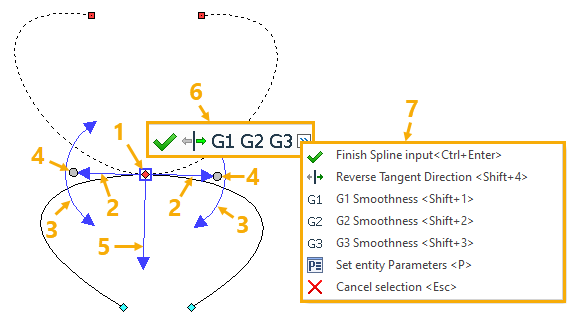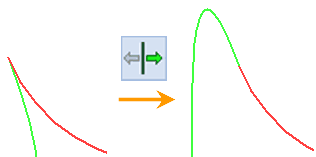2D Spline Point Controls |
  
|
Information in this section is applicable both to construction splines and graphic splines.

1 - Point coordinates manipulator
2 - Derivative length (tangency tension) manipulators
3 - Derivative angle (tangency direction) manipulators
5 - Curvature radius manipulator
6 - Dynamic toolbar
7 - Drop-down menu
When editing a spline, you can select ![]() any of its control points either in the list of points within the parameters window, or in the view window. For
any of its control points either in the list of points within the parameters window, or in the view window. For ![]() Spline and
Spline and ![]() Closed Spline, upon selecting a point, following manipulators appear in the view window:
Closed Spline, upon selecting a point, following manipulators appear in the view window:
Selected point is enclosed within a blue rectangular frame. Move the cursor over the frame. The point gets highlighted in blue, indicating that the system is ready to change point coordinates. Upon clicking ![]() within the frame, the point starts following the cursor. X and Y coordinate values in the parameters window and preview of spline curve change accordingly. Set the desired position of the point, then click
within the frame, the point starts following the cursor. X and Y coordinate values in the parameters window and preview of spline curve change accordingly. Set the desired position of the point, then click ![]() to confirm new coordinates.
to confirm new coordinates.
Derivative length (tangency tension) manipulator
Derivative length manipulators are the two blue straight arrows pointing in opposite direction along derivative vector at the selected point. Move the cursor over one of the arrows. The arrow gets highlighted in red, indicating that the system is ready to change derivative length. Upon clicking ![]() the arrow, length of both arrows starts to change in accordance with the movement of the cursor along the derivative vector. Length value in the parameters window and preview of spline curve change accordingly. Set the desired length, then click
the arrow, length of both arrows starts to change in accordance with the movement of the cursor along the derivative vector. Length value in the parameters window and preview of spline curve change accordingly. Set the desired length, then click ![]() to confirm the new value.
to confirm the new value.
The length of manipulators may differ from the actual length of derivative vector. It is scaled for convenient manipulator's appearance.
Derivative angle (tangency direction) manipulator
Derivative angle manipulators are the two blue arc-shaped bidirectional arrows located at the tips of derivative length manipulators. Move the cursor over one of the arrows. The arrow gets highlighted in red, indicating that the system is ready to change derivative angle. Upon clicking ![]() the arrow, all manipulators start rotating in accordance with the movement of the cursor around the selected point. Angle value in the parameters window and preview of spline curve change accordingly. Set the desired angle, then click
the arrow, all manipulators start rotating in accordance with the movement of the cursor around the selected point. Angle value in the parameters window and preview of spline curve change accordingly. Set the desired angle, then click ![]() to confirm the new value. Angle is measured counterclockwise and zero angle value corresponds to the horizontal right direction of the vector.
to confirm the new value. Angle is measured counterclockwise and zero angle value corresponds to the horizontal right direction of the vector.
Derivative manipulators are two gray circles located at the tips of derivative length manipulators. Move the cursor over one of the circles. The circle gets highlighted in orange while length and angle manipulators get highlighted in red, indicating that the system is ready to change both derivative length and angle at once. Upon clicking ![]() the circle, all manipulators start rotating in accordance with the movement of the cursor around the selected point and, in the same time, length of length manipulators starts to change in accordance with the movement of the cursor along the derivative vector. Length and Angle value in the parameters window and preview of spline curve change accordingly. Set the desired length and angle, then click
the circle, all manipulators start rotating in accordance with the movement of the cursor around the selected point and, in the same time, length of length manipulators starts to change in accordance with the movement of the cursor along the derivative vector. Length and Angle value in the parameters window and preview of spline curve change accordingly. Set the desired length and angle, then click ![]() to confirm new values.
to confirm new values.
Curvature radius manipulator is a single blue arrow pointing in normal direction to derivative vector at the selected point. Move the cursor over the arrow. The arrow gets highlighted in red, indicating that the system is ready to change curvature radius. Upon clicking ![]() the arrow, its length starts to change in accordance with the movement of the cursor in normal direction to the derivative vector. Radius of Curvature value in the parameters window and preview of spline curve change accordingly. Set the desired radius, then click
the arrow, its length starts to change in accordance with the movement of the cursor in normal direction to the derivative vector. Radius of Curvature value in the parameters window and preview of spline curve change accordingly. Set the desired radius, then click ![]() to confirm the new value.
to confirm the new value.
The length of manipulator may differ from the actual radius of curvature. It is scaled for convenient manipulator's appearance.
If selected point has custom accuracy applied, then none of the aforementioned manipulators are displayed.
If the selected point has default values of derivative length, derivative angle and radius of curvature, then arrows of manipulators are shown in light blue, if custom values - in deep blue.
Regardless of the type of the spline, the dynamic toolbar appears in the view window, upon selecting a spline's control point. The dynamic toolbar contains the same set of options as the automenu. However, some of the options are displayed in the toolbar instantly, while others are hidden within the drop-down menu. In order to invoke the drop-down menu, click the ![]() button located in the right side of the toolbar. If the selected point is not snapped to a graphic line, then following options are available in the automenu and dynamic toolbar:
button located in the right side of the toolbar. If the selected point is not snapped to a graphic line, then following options are available in the automenu and dynamic toolbar:
|
<Ctrl>+<Enter> |
Finish Spline input |
|
<P> |
|
|
<Esc> |
Cancel selection |
For ![]() Spline and
Spline and ![]() Closed Spline, if the selected point has custom parameters, the following option is additionally available:
Closed Spline, if the selected point has custom parameters, the following option is additionally available:
|
<Shift>+<4> |
Reverse Tangent Direction |
Activating this option switches direction of spline's derivative vector at the selected point to an opposite one.

Moreover, if the selected point is snapped to a graphic line, following options are additionally available:
|
<Shift>+<1> |
G1 Smoothness |
|
<Shift>+<2> |
G2 Smoothness |
|
<Shift>+<3> |
G3 Smoothness |
Activating one of these options makes the spline tangent to the snapping line at the selected point. Each option corresponds to a particular type of tangency (smoothness). The detailed information on tangency types can be found in the Main Concepts of 2D Spline section.
See also: